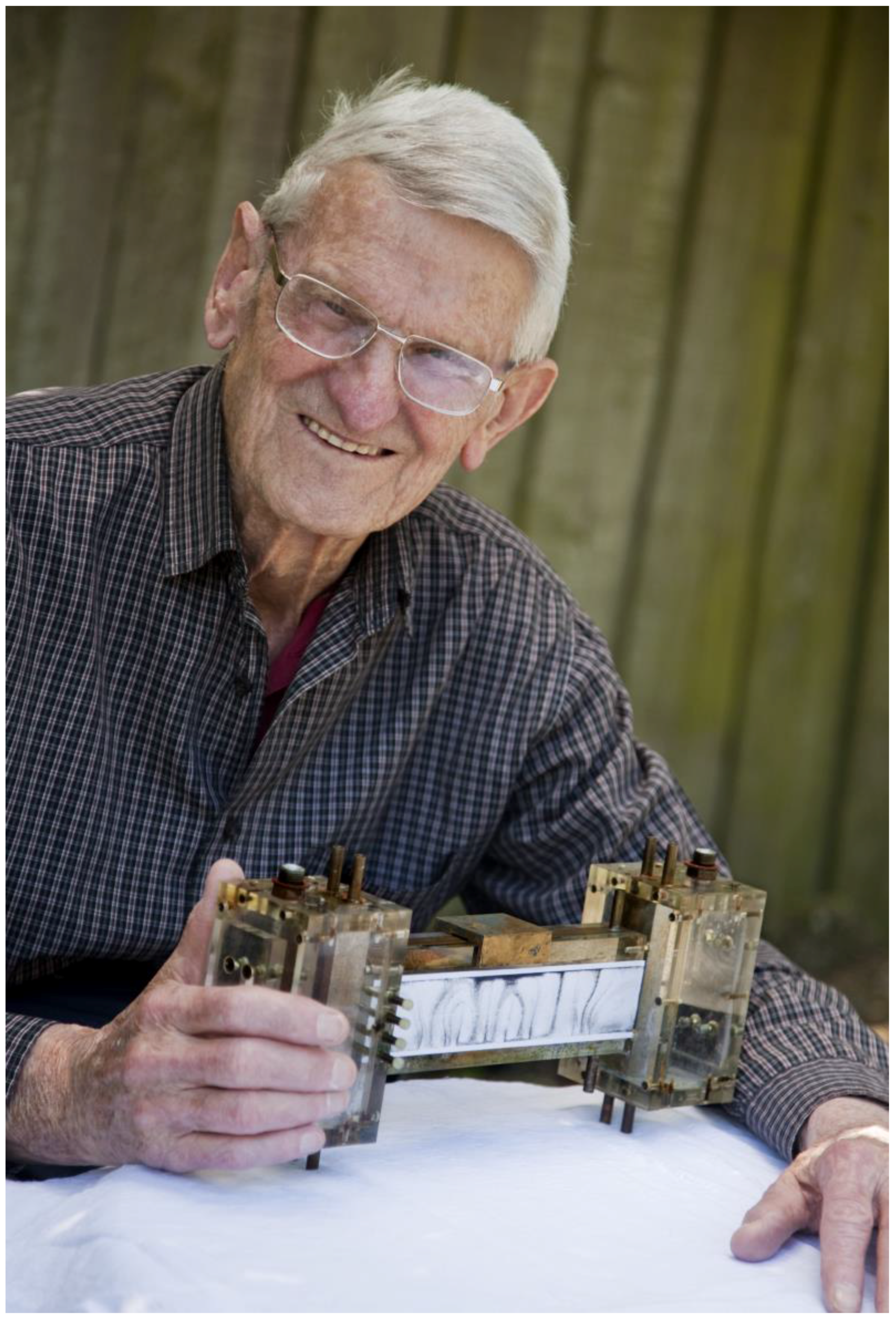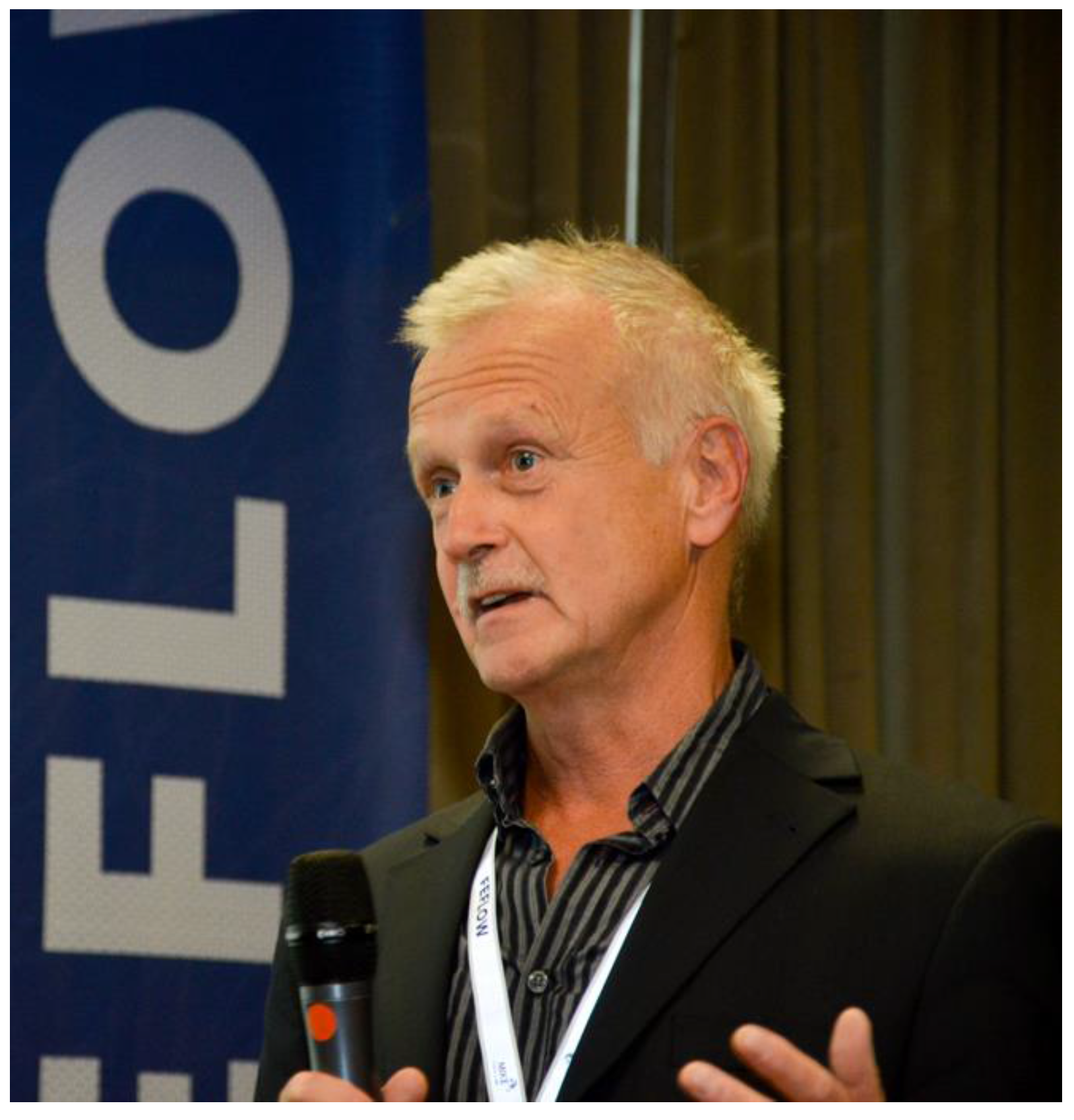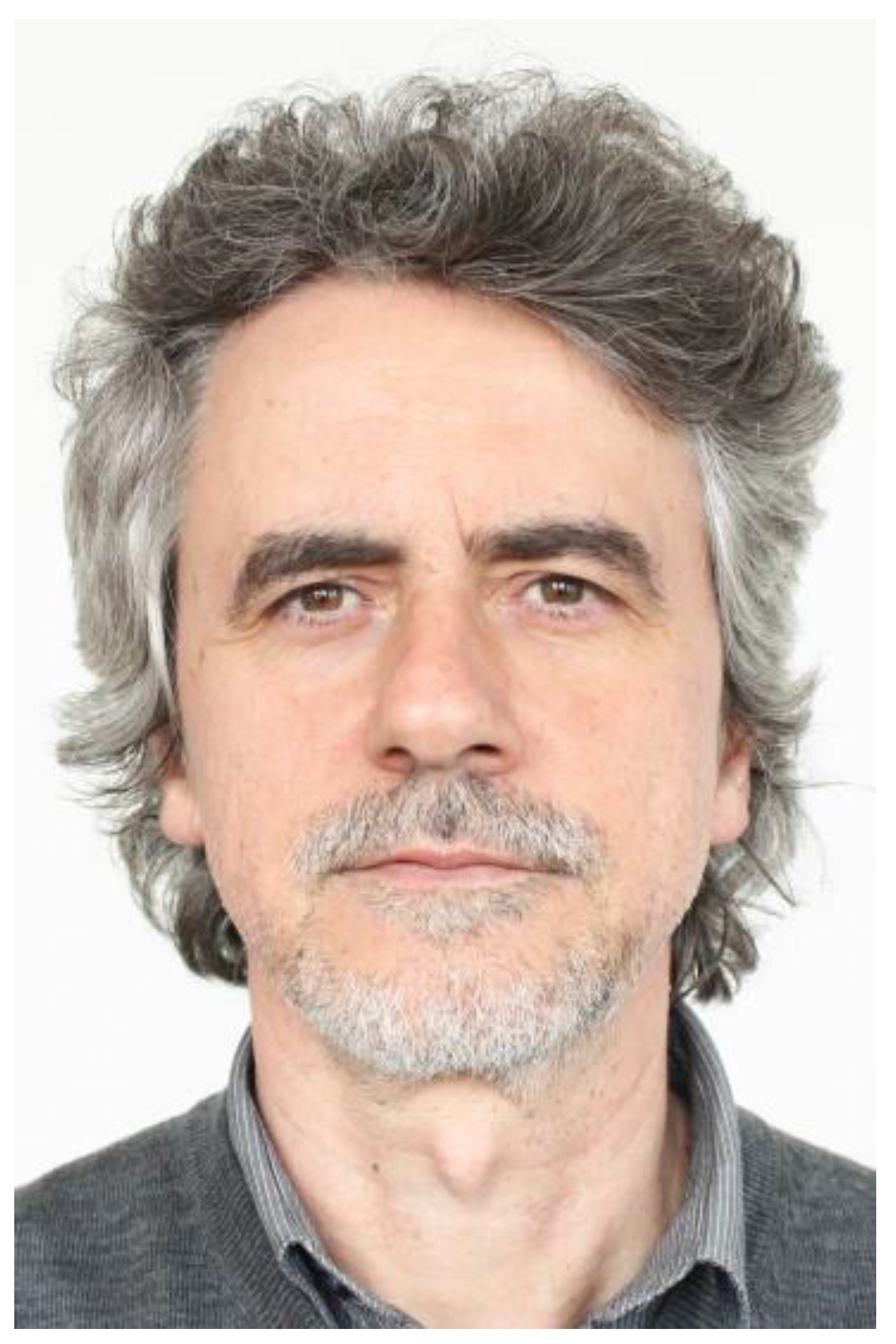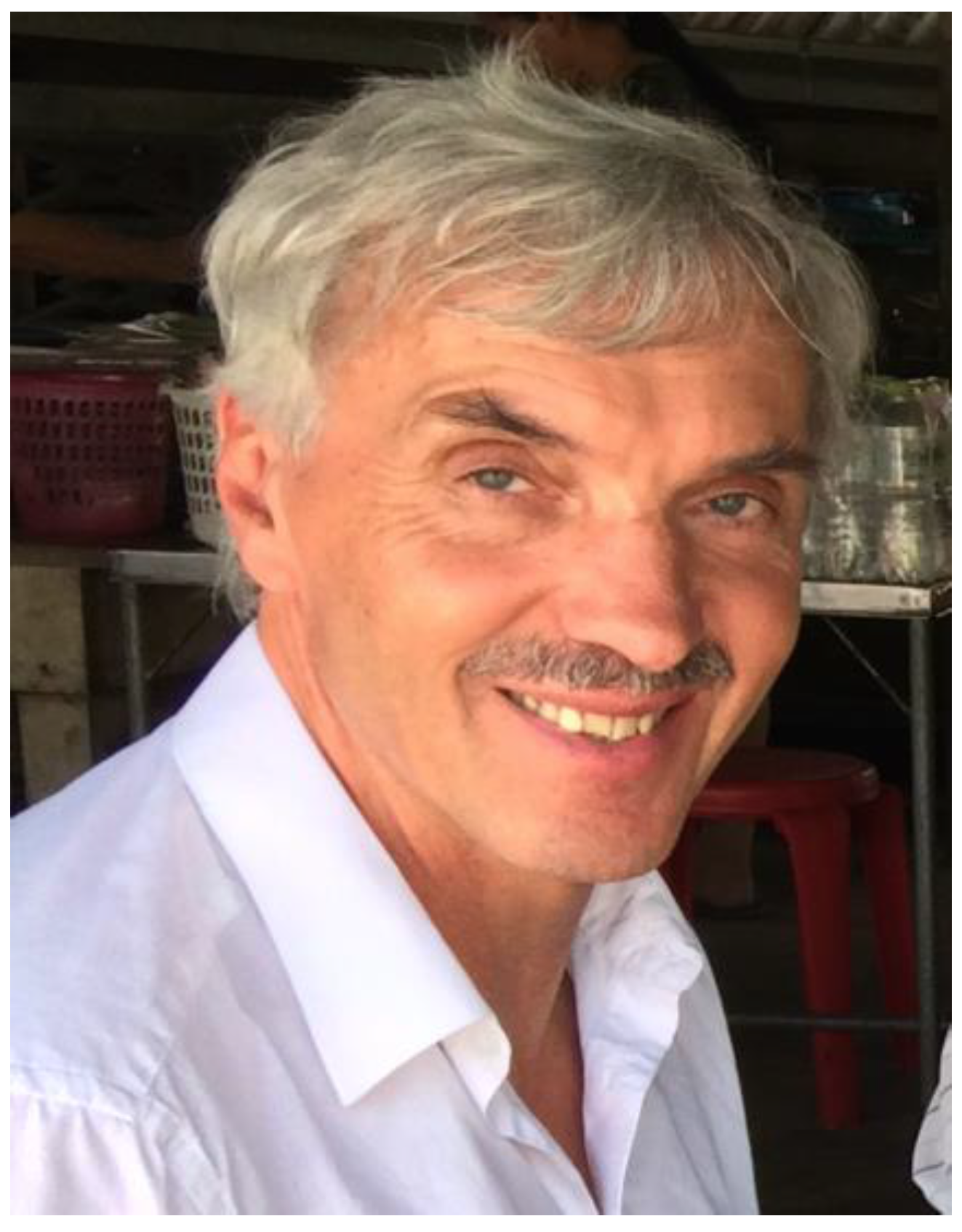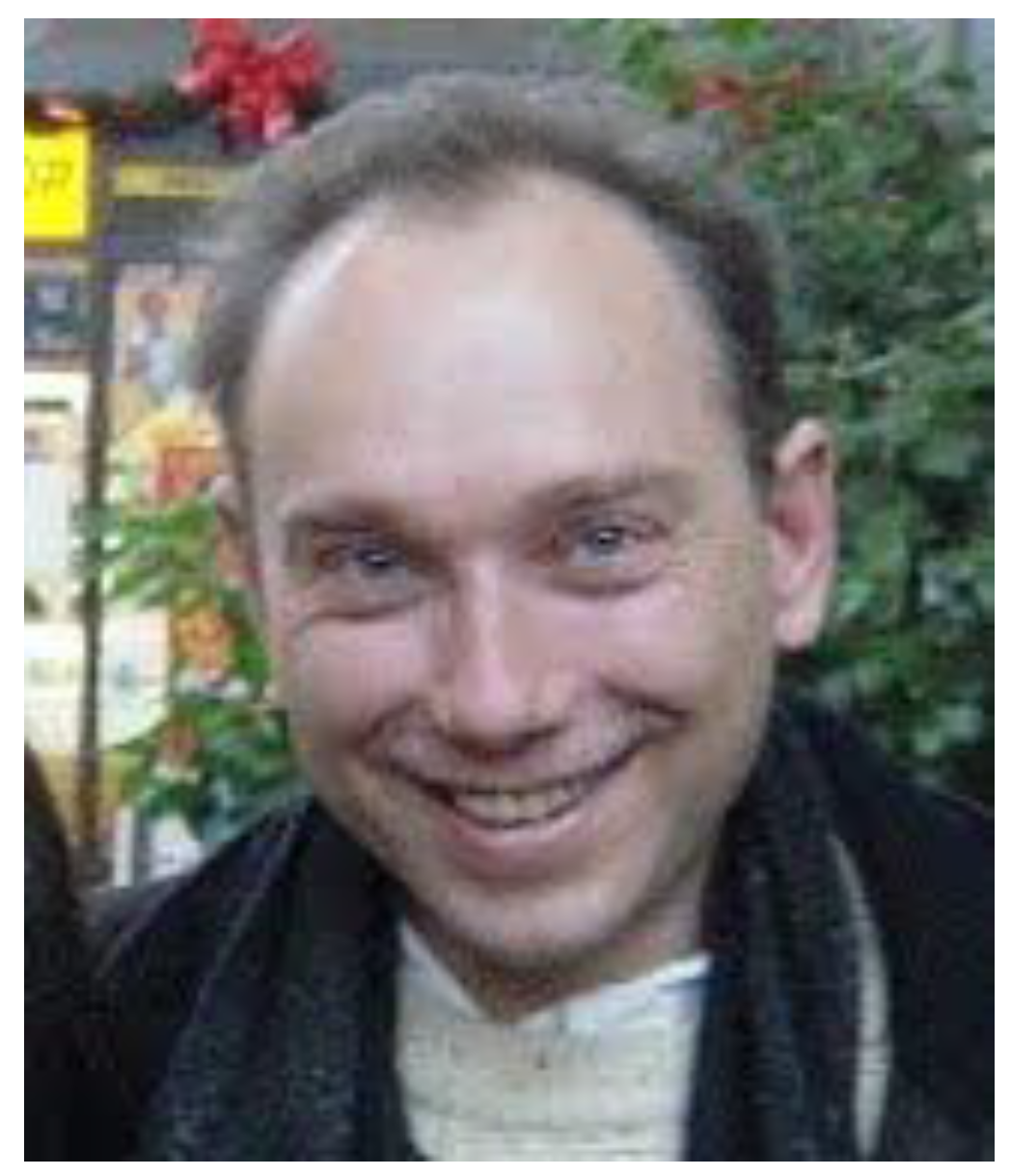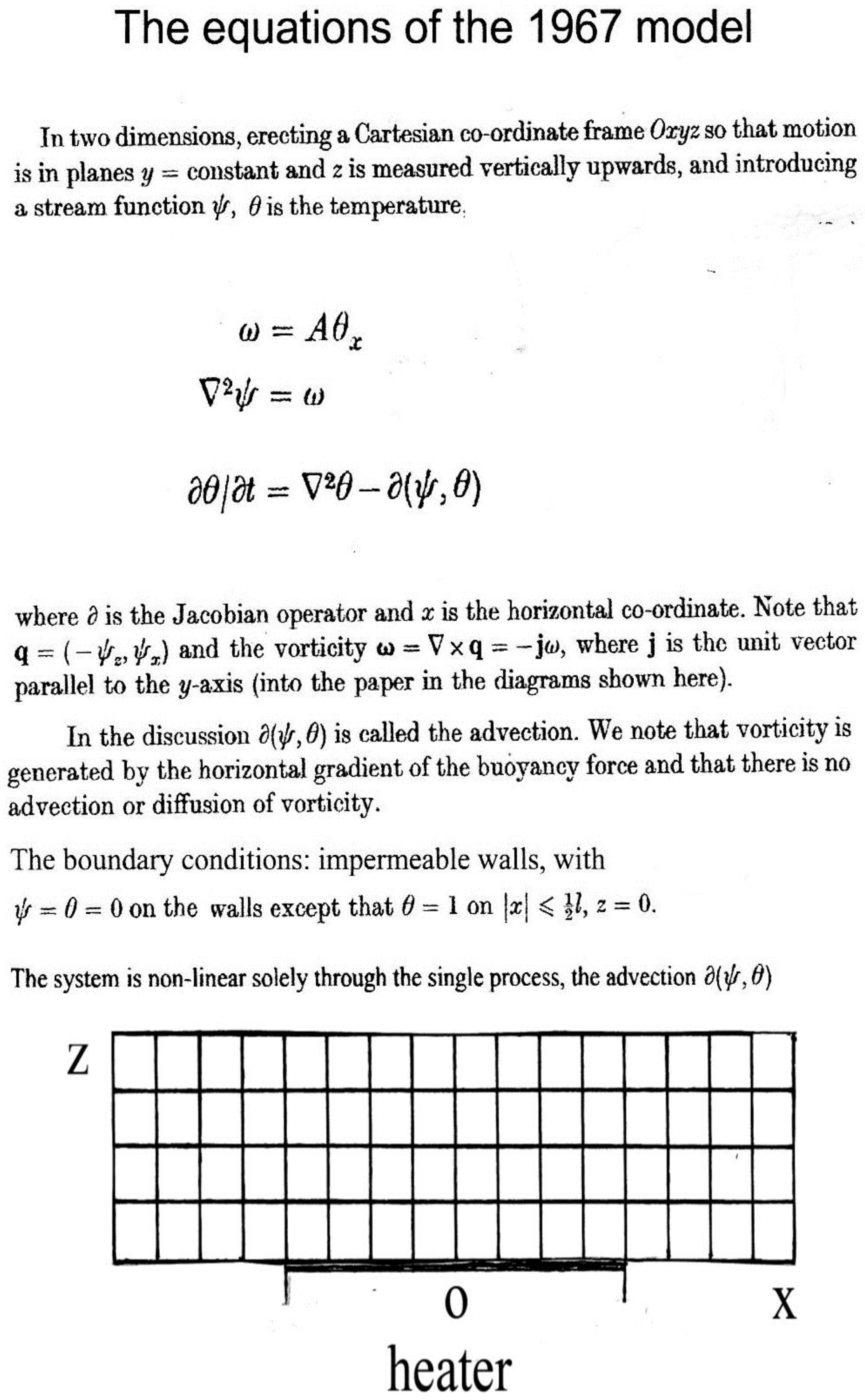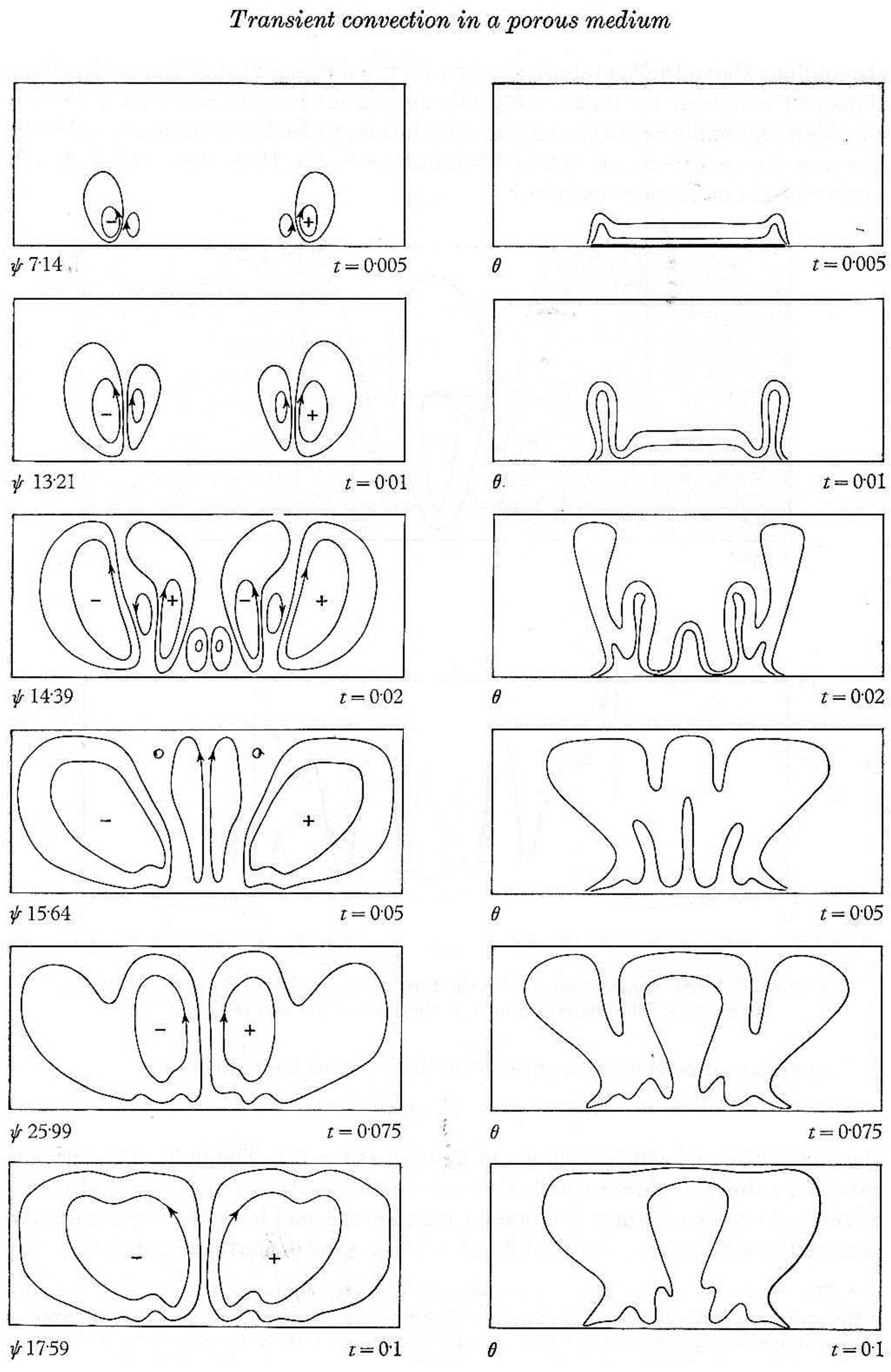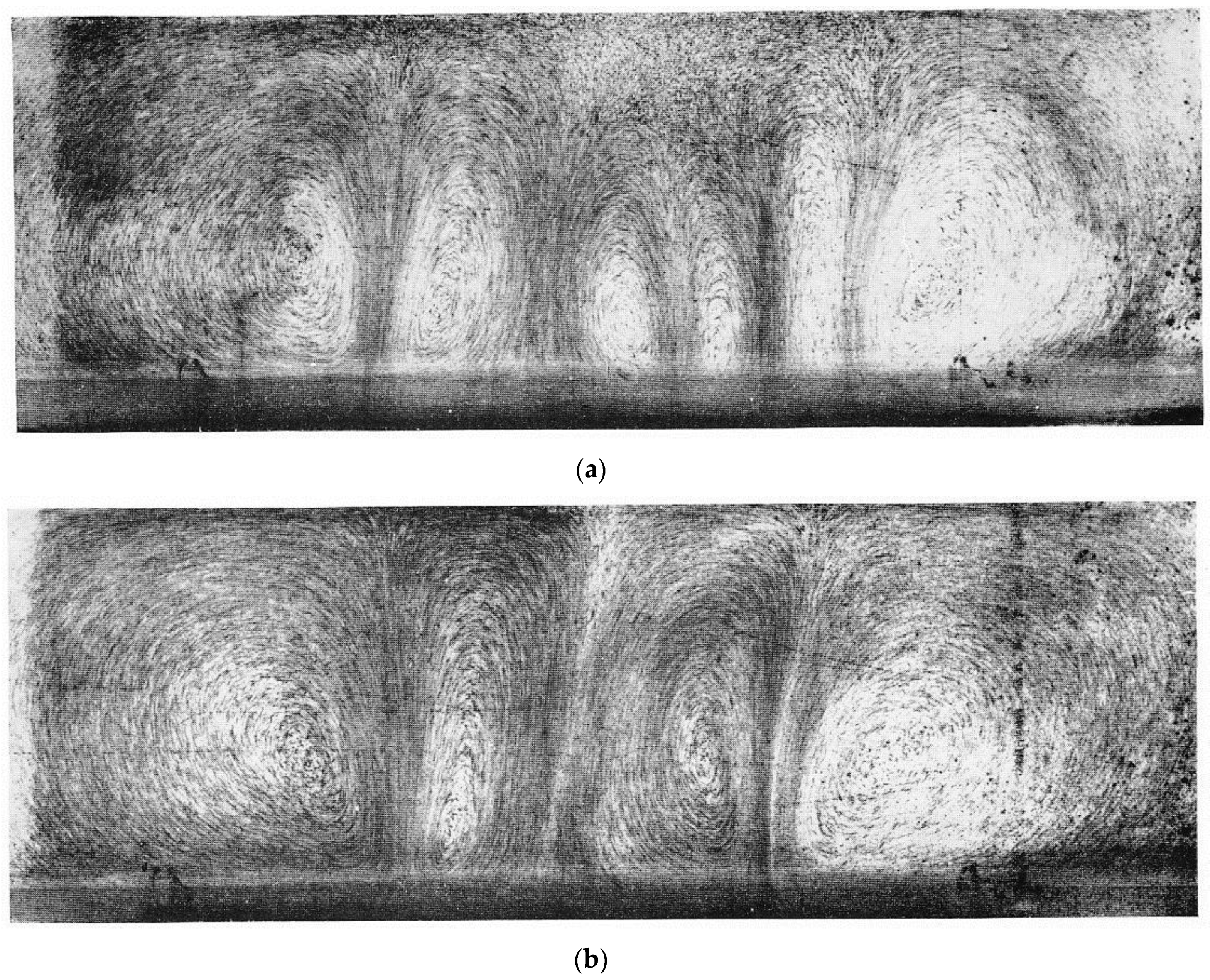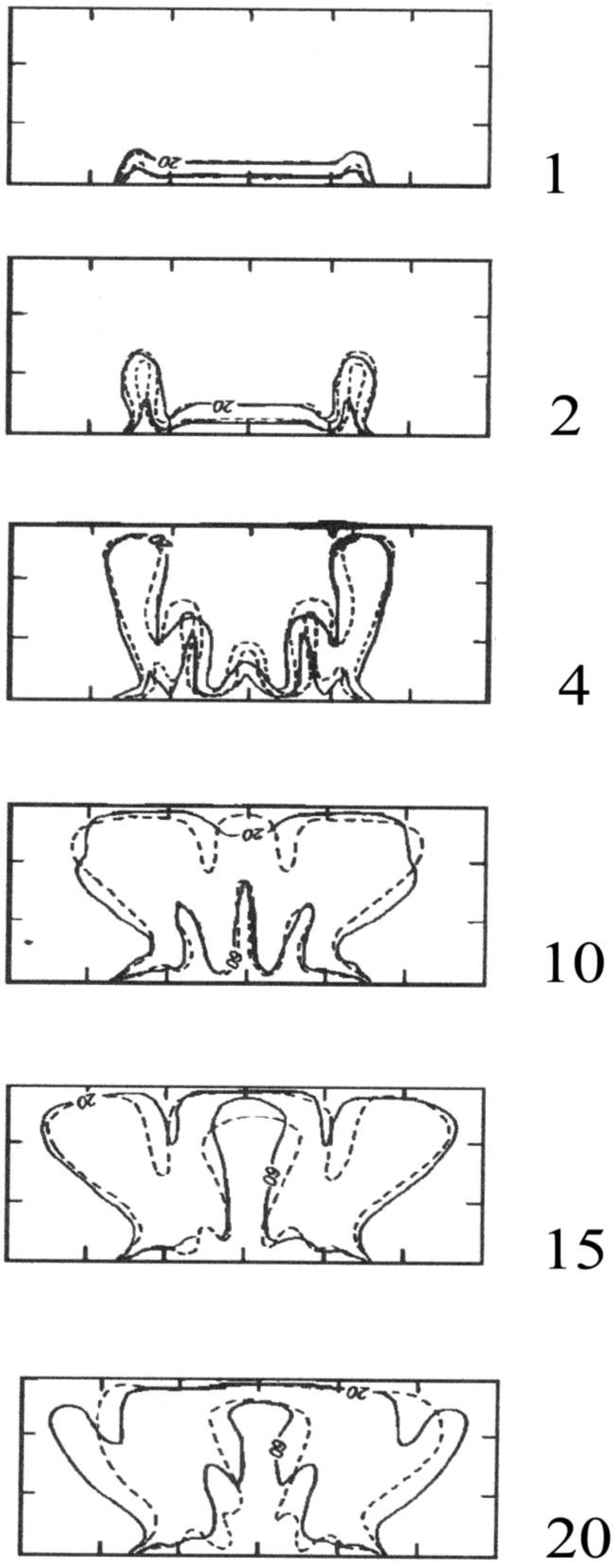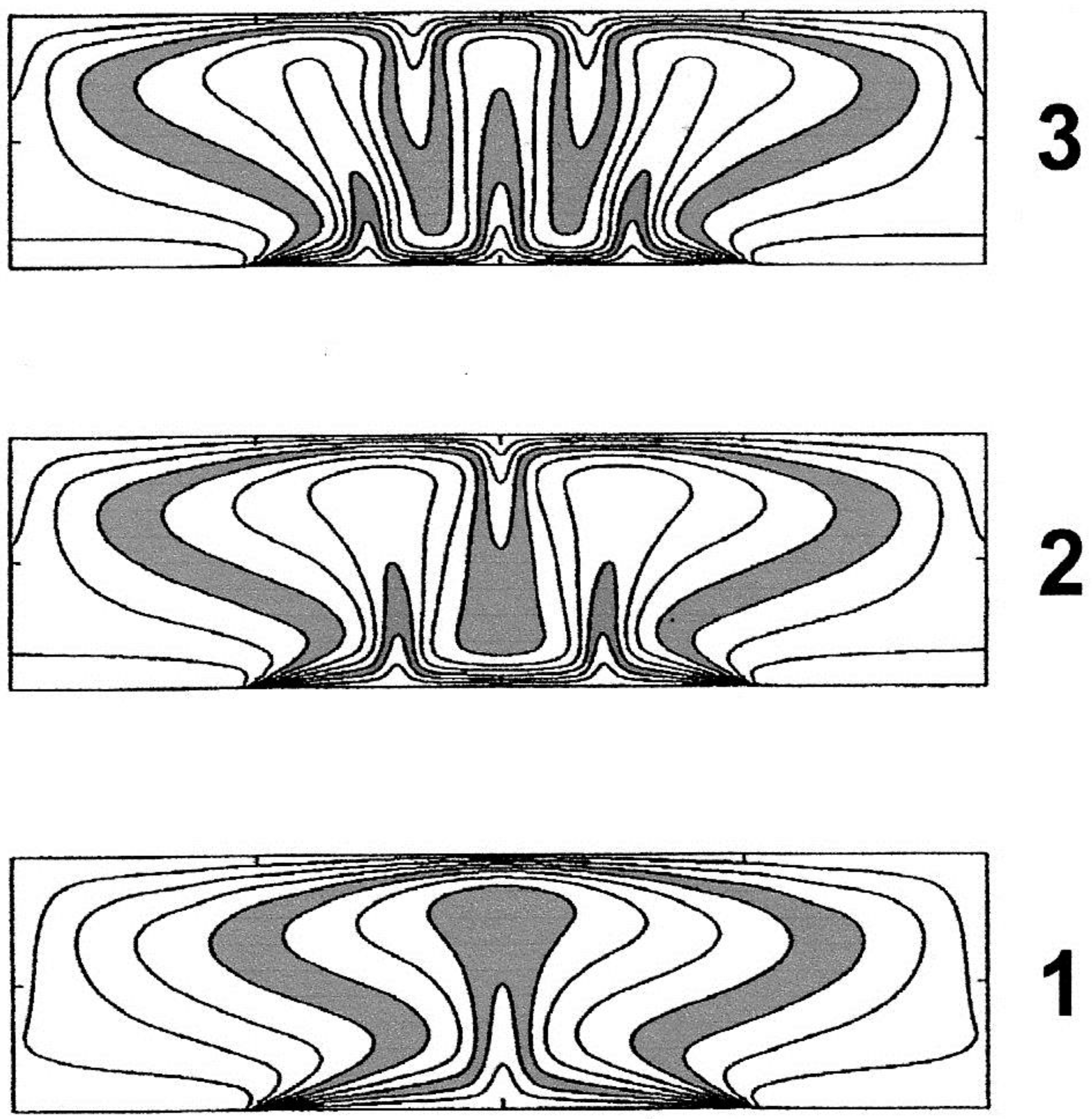This part of the paper is an autobiographical reflection by John Elder, in his own words.
5.1. Origin of the Model System
5.1.1. 1953/1954 The Dawn: Geothermal and All, Department of Scientific and Industrial Research (DSIR), Wellington
The beginning: November 1953
We are in Courteney Place, Wellington, New Zealand.
Along the street on the south side we see a young tall-skinny chap.
As he walks eastward along the street he keeps looking up.
He is trying to find the Applied Mathematics Division of the DSIR.
A bit down the street, a sturdy middle-aged man exits a building, comes onto the footpath and starts walking westward.
He sees the young chap; sees what he is doing.
He stops and waits in the young chap’s way.
He speaks: “Are you John Elder?”.
“Yes” says the young chap.
“Ah, we have been expecting you. I’m Bob Williams, the director.
Up those stairs. I’ll see you later. A desk is there for you.
On it is a report for you to read and assess.”
Lo and behold. Who is that there!?
It’s Roy Kerr, a University colleague, later of black-hole fame!
Brilliant. So we vacation-jobbers were in it together.
(Oh, yes, and later we were also together at Cambridge.)
And So it Began!
At the Applied Mathematics lab, the initial task was to assess a mathematical model (proposed by Frank Henderson in 1950) of a hypothetical system with porous ground filled with steam—presumably suggested by the apparent experience at Larderello (Italy).
Well, by mid-morning of our first day we realized the derivation of the model equations was erroneous. Correctly derived it gave a non-linear system for which (in our consideration) was not soluble analytically by any existing technique. Not to mention, it was by then known, the ground at Wairakei was permeated not by steam but by hot liquid water.
Our task having evaporated, we were told to do anything we liked to help understand what kind of a system we had at Wairakei and how it worked.
I spent my time talking with geologists, geochemists, geophysicists, engineers and all (a pressure cooker course in practical geology!) and made a collection of existing data. I spent a lot of time in the geothermal zone itself. I stayed in the Ministry of Works camp at Taupo, and travelled back and forth with the workers. I paid particular attention to the natural phenomena—steaming ground, fumaroles, hot-boiling-erupting springs and the existing experiments on the flow of boiling fluids up wells and along pipes. I even climbed to the top of the big drilling rig!
I learnt a helluva lot! A seed was planted. I had unexpectedly entered a fascinating world within which much of my scientific life was to revolve. However, that was quite unbeknown—away over the far horizon.
For our Applied Maths project, I had no immediate suggestions other than what might be learned from small-scale physical models—already a well-established technique in many fields, notably in fluid dynamics.
The Wairakei Geothermal Project
In the North Island of New Zealand there are several thermal districts where steam or hot water is discharged at the surface. The Wairakei thermal area is part of a geothermal system which extends from Ruapehu to White Island and beyond. These are manifestations of an active volcanic system. They are different from hot springs, such as those found in the South Island, which draw on the passive background heat flux from the Earth’s deep interior.
The hot water and steam of hot pools had been and are used by the first settlers of New Zealand —the Maori. A famous such place is at Rotorua.
Over the years various proposals were made for use of these natural hot waters. By 1953 the project at Wairakei was well established. The site had been selected following the work of Eddie Robertson and Frank Studt of the Geophysics Division, DSIR assisted by geologists, geochemists and engineers. This was pioneering work. At the beginning, what was down there was a mystery.
The first bores found liquid hot water at depth. This was a surprise for those who thought Wairakei was like Lardarello.
As this water rises in the bore-hole it boils to produce a mixture of boiling water and steam. There were 2 possible uses of the energy of the hot water: generation of electricity by using the pressure of the steam; the strongly preferred option, production of ‘heavy water’.
The ‘heavy water’, extracted by a distillation process, would be used in the UK for their nuclear programme. This option was dumped in 1956—too costly. I was told the option was never a go, after it was found the initial costings were incorrectly low by arithmetic error!
5.1.2. 1951–1955 at University in New Zealand
At Canterbury University College (of the University of New Zealand) I did a double MSc: one in mathematics (option hydrodynamics); and one in physics (thesis an experimental study of alkali-halide activated alkali-halide phosphors).
At that time, each year, after rigorous competition, the New Zealand government sponsored 6 graduates: 3 years at a suitable institution abroad followed by 3 years at an appropriate place in New Zealand. So I was offered a place at Cambridge, in the Cavendish as a PhD student in fluid mechanics and then at Geophysics Division of DSIR.
[And so during November-December 1955, by ship with 1200 others: I sailed away across the Pacific; through the Panama Canal; across the Atlantic to the land of chimney pots (first impression on board at the wharf).]
5.1.3. 1956–1958 Cavendish Laboratory, Cambridge University
This mecca of physics opened in 1874. In my years there, on and off during 1956–1970, it was run by Nevill Mott (1954–1971). He had been preceded by: Maxwell, Rayleigh (of the number!), Thomson, Rutherford, Bragg. I was in his presence only 3 very brief times. However, I had met him first in the mathematical-physics course at Canterbury University College through his book (on solid state physics, joint authored). When I arrived the place was still buzzing with the 1953 discovery of the structure of DNA by Crick and Watson.
Fluid mechanics initially had rooms in part of the ‘Old Cavendish’. We research students occupied a large room, in which was a plaque reading “Here Kelvin determined the Ohm”—or words to that effect. There was a workshop and lab space here and there and equipment including a wind tunnel with associated measuring gear notable for hot-wire anemometry. We also had the use of the facilities in the fluid mechanics laboratory in the Engineering school.
(Early on we were moved into the nearby ‘New Cavendish’. The whole Cavendish was moved to west Cambridge during 1971–1974.)
We fluid mechanics types were a mixture of budding and established applied-mathematicians and experimental-physicists (and/or both). The group was led by George Batchelor and Alan Townsend (my supervisor)—both Australians. George, an applied-mathematician, was the organizer supreme. Alan, essentially an experimentalist, was a pioneer in the study of turbulent flow. Also there was Geoffrey Ingham Taylor (known as ‘GI’), the grand old man of fluid mechanics (always both), active since the 1920s, and still going strong at 80.
In the midst of various research topics for my PhD I made my first laboratory model of convection in a porous medium. It was nothing more than a cylindrical container, with insulated walls, filled with a porous layer, of water saturated sand of measured permeability. The bottom of the container was fitted with a flat electrical heater, insulated below, together with current and voltage meters to measure the power input. The top had a thin cylindrical metal box through which cold water could flow. The temperatures of the top and bottom of the sand were measured with thermocouples.
For each experiment: the power input (P) was set until there was a steady state, as indicated by the temperature difference (T) across the porous layer. So we obtain P(T). If the transfer of heat were by conduction then P/T = a constant. What we find, for sufficiently large T, is that P is very much larger than for conduction. We find, more or less, P/T2 = another constant.
Some other process must be at work. The heat is transferred by convection: by the flow of the fluid moving through the porous/permeable medium because of unbalanced pressures arising from density differences produced from temperature differences.
The heat output of the Wairakei system had already been measured, more or less (by volcanologist, Jim Healy). Of course, such a simple model is an extreme idealization, but my experimental results were enough to indicate that the main heat transfer mechanism at Wairakei could be predominantly convection in a porous/permeable system.
*
In 1957 I had another notable event. I met EDSAC 2—the computer built and run in the Maths Lab (as it was then called). I attended the short first formal course in its use. It had 2k core and 2k pre-programmed Read-only memory (ROM) (including a Runge-Kutta routine). Programming was with a weird and wonderful assembly language. Input and output was via 5-hole punched tape. However, what a giant leap! (The only other comparable machine in the UK was at Manchester University.)
5.1.4. 1959–1961 Geophysics Division, DSIR Wellington
After John’s first taste of Cambridge, as part of his contract he is back in New Zealand in Geophysics Division, DSIR, Wellington working on geothermal studies.
A major task was to repeat the Cambridge model but on a much larger scale, aiming to perhaps model the order of systems in the field. The container was 1.5 m wide and 0.5 m deep with transferred power up to 10 kW. A single experimental run lasted several days.
The results confirmed the Cambridge model results.
The heat flow through the surface of the Earth, outside the thermal zone, was measured using the temperature profile down a derelict 700 m deep bore near New Plymouth together with the measured thermal conductivity of the local rocks. The heat flux is near the normal global value (50 mW/m2) [contrary to the suggestion of a high regional heat flux].
Among my other projects were simple quantitative models: the entire Wairakei system using existing data; the surface discharges: steaming ground, fumaroles, hot springs, geysers, bores.
This was a very busy and fruitful time for me.
5.1.5. 1961–1962 Where Next?
The 3-year ‘tour of duty’ would soon come to an end in 1961. What could John do then!?
Through George Batchelor, as ever running the fluid mechanics group at Cambridge, my name had been mentioned and after interrogation by George Backus by post I had a place, for 1964 or so, at the new Institute of Geophysics and Planetary Physics (IGPP), (premises yet to be built) in La Jolla, San Diego, California. There would be a place for me in Cambridge, in a year or so on a new grant for studies relevant to oceanography, being arranged by George Batchelor and to be occupied initially by myself and Owen Philips.
[He was the first to produce a valid theory of the generation of water waves by a turbulent wind.]
To cut a long story short: Lady Luck was on my side.
1961 July–September Geophysics section, Geological Survey of Japan (Kawasaki-shi). I gave talks about Wairakei-and-all in the mathematics department at the Hongo campus of Tokyo University; at the Ochanamizu (honorable tea for water) national women’s university; and the Geothermal Society. This lead to consulting visits to possible-electric-generation geothermal sites at Matsukawa, Oshima and Kyushu.
I used a mental picture of the distribution of hot water in the ground of a geothermal site, down to depths of several kilometers, as like a very big mushroom, with the deepest hot water flowing up the stem and spreading into a cap-like structure as the water nears the surface. Hence I was given the nickname “Matsutake”. (matsu = pine tree, take = mushroom − a mushroom found under pine trees).
In the laboratory I repeated the Cambridge convection experiment but with a cylindrical concentric heat source inside the sand and water filled container—as a vertical cylinder (of radius much smaller than that of the container). This arrangement also gave results similar to those of the Cambridge model.
1961–1962 Colliet al Tabia (College of Medicine), Mosul, part of the University of Baghdad: to be the Professor of Physics, teaching physics to med students. [A long time before all the present troubles.] It was to be a quite extraordinary and wonderful year. I was a busy boy but found time to write up my work in New Zealand as ‘Hydrothermal systems’ DSIR Bull 169. 115pp, 1966 (For which I was awarded a ‘Geophysics prize’ by the New Zealand Royal Society).
1962 August–September Larderello. Also I was lucky to land a short-term job with the Società Larderello for a study of the local Tuscan steam fields. I had access to the bore logs. I spent a lot of time wandering around the district. Slowly it dawned on me that the system was just a giant version of my (Wairakei) model of steaming ground.
5.1.6. 1962–1964 Here Again: Back in Cambridge
The fluid mechanics group still had its laboratory in the “New” Cavendish building. We had a long-term visitor, on leave, Robin Wooding, another kiwi. He had already done, and was to do more work on convection in a porous medium. We first met in the Applied Maths lab in Wellington.
He knew of my interest in simple models of geothermal systems. One day he asked me if I was familiar with the deduction of HSJ Hele-Shaw: the flow of a viscous fluid between a pair of close parallel impermeable sheets behaves as if it were in a medium of uniform permeability. I had never heard of it. However, within the hour I had found it written up in my copy of the fluid dynamics bible (old testament, Lamb’s Hydrodynamics). Within another hour I was able to deduce, with the usual simple approximations, that the same kind of flow, as in a permeable medium, would also exist for convection in a Hele-Shaw cell.
I cannot thank Robin Wooding enough for his most fruitful query/remark.
Using such cells was to become a major part of my research. However, I did not immediately do anything with this. I got way laid. After my return, to get back into my stride, I tried a miscellany of simple convection experiments. Among these, with no clear focus I decided to see, by experiment, what I could find, by measurement and visualization, about the convective flow, laminar and turbulent, up a hot vertical wall of a container of a viscous fluid.
Perhaps nothing very new about that, just turning the handle. So I stumbled over the hitherto unknown phenomenon of a vertical stack of convective cells in what I called a “vertical slot”.
The first apparatus was the annular space between 2 concentric vertical cylinders, the inner heated, the outer of glass (from an old-fashioned petrol bowser). The motion was visualized with aluminium powder suspended in the fluid. One morning, I had set the next experiment going and at 11am went to the usual morning tea with the Cavendish mob. I returned to the lab. I got a mighty surprise. I could see it on the other side of the lab. The flow had generated a steady stack of toruses. I saw, on close inspection: the direction of the motion within the toruses was all the same.
I was hooked. In an instant, plan A dropped. I did a lot of experiments with flows in vertical slots. The numerical modelling of these flows was started later while I was at IGPP.
5.1.7. 1964–1965 Institute of Geophysics and Planetary Physics (IGPP)
Institute of Geophysics and Planetary Physics, UC San Diego at La Jolla
In the Scripps Institute I gave a graduate lecture course on geophysical/oceanographic fluid mechanics. I did a variety of convection experiments notably Hele-Shaw cell models of free convective systems of sea water within sub-ocean-ridges. [Oh, and I did a lot of surfing!]
IGPP was into computers in a very big way. For example, they had written Bullard Oglebay Munk Miller (BOMM) a super-level language (itself written in Fortran) for analysing (geophysical) time-series data recorded on digital mag-tape. When I arrived they had just wrapped up a gigantic project, based on several sites, spanning the Pacific, recording wave height, to allow tracking waves which travel right across the ocean.
So no surprise, the main new big step for me was access to quite powerful computers, initially a CDC1600 and later CDC3600—programming in Fortran, the work horse of the day. A rough-and-ready form of diagrammatic output (shown as sequences of isolated dots) was possible on the line printer output. I did several different numerical experiments, including quite an elaborate numerical study of convection in a “vertical slot”.
I cut my teeth on numerical modelling with systems of non-linear partial differential equations—being able to handle things hitherto all but impossible. For me, a door had opened into a new world.
5.1.8. 1966–1970 All Together Now: DAMTP
Department of Applied Mathematics and Theoretical Physics, Cambridge
set up and run by George Batchelor in 1959:
originally in the Old Cavendish (Free School Lane);
from 1964 in the old CUP (Silver Street); and from 2009
in the Centre for Mathematical Science (Wilberforce Road)
The new department originally combined various groups such as astrophysics and fluid mechanics.
Yet again back in Cambridge.
Busy (in the old CUP) with setting up and running the fluid mechanics laboratory with Tom Brooke-Benjamin handling the gear (2-man workshop, 1-woman darkroom/draughting, flume, rotating table, etc.) and me on measurement equipment.
I set-up and ran a hybrid-computing course for our grad students. This was with a linked digital and analogue computer, a common tool at the time. The digital computer was a Digital Equipment Corporation PDP8, one of the first mini-computers. This instrument provided a very versatile tool for controlling experimental apparatuses and handling measurements. It was also useful for experimenting with systems of non-linear ODEs. (In 1965 I had been on a 2 week full-time residential hybrid-computing course in Los Angeles, USA.)
A major project during 1969/1970 was setting up my brain-child CATAM “Computer Aided Teaching of Applied Mathematics” (original name, later ‘applied’ changed to ‘all’). It ran on a TSS8, a PDP8 with 32k memory plus an additional 256k drum memory and a dual magnetic tape machine with removable reels, altogether providing a local time-shared system for 16 users on teletype machines. I started the project with 4 full-timers: 1 electronics, 1 software, 2 operators; and part-timers: a guinea-pig student and several colleagues for demonstrations and all. For its time, it was quite a pioneer.
The project is still on air, vastly changed. It plays a part in the Maths Tripos. The student work can be done with several software packages but the supported software package is MATLAB.
The Maths Lab
Before long I had another string to my bow. The Cambridge Maths lab now had ‘Titan’, a very powerful computer. The nice things, from my point of view, were: an easy-to-use programming system-and-language; but especially diagrammatic output could be written as continuous lines on a Calcomp plotter.
I became a heavy user. I was given a key to the lab. The machine was normally run as a batch processor with input via punched tape. This was OK. However, one tiny defect on the tape or a tiny programme error killed your job. However, that door key, in the midnight, gave me direct access to the machine. The operator would easily fit you in. You could see how your run was going by watching the line-printer or plotter and if bad have the operator stop the job. With just a few seconds here and there you could get done in a couple of hours what otherwise could take a week or more, and still have big runs done in batch. There was a small group of us nerdy night owls. We learned a lot from one another.
I was asked to run a course on numerical methods for PDEs for the graduate-level computer-science programme.
As part of all that, I wrote a front-end, using Titan’s standard programming language to make a sort of mini-super-level programming language, for systems of PDEs, which I called KNEES (=numerical experiments with elliptic systems). The user wrote a main programme, in this mini-super-level language, setting out the model equations, and initial and boundary conditions, more-or-less as they are written mathematically. Even a very elaborate and complex model could be defined and written on a single page often in much less than an hour. [Of course, the user could include code of the standard programming language.]
5.1.9. And Not Least We Have 1966–1967
I set out to make a detailed study of free convection in a permeable medium in 2-dimensions using numerical and experimental methods. The numerical experiments were started while I was at IGPP and continued at DAMTP.
The paper (Transient convection in a porous medium.
J. Fluid Mech. 1967,
27, 609–623 [
2]) was focused on the comparison of the experimental observations together with simple numerical methods for both a steady state solution and the corresponding (with the same boundary conditions) numerical time-dependent solution—as much as anything to give confidence in the use of the numerical methods.
That was it!
